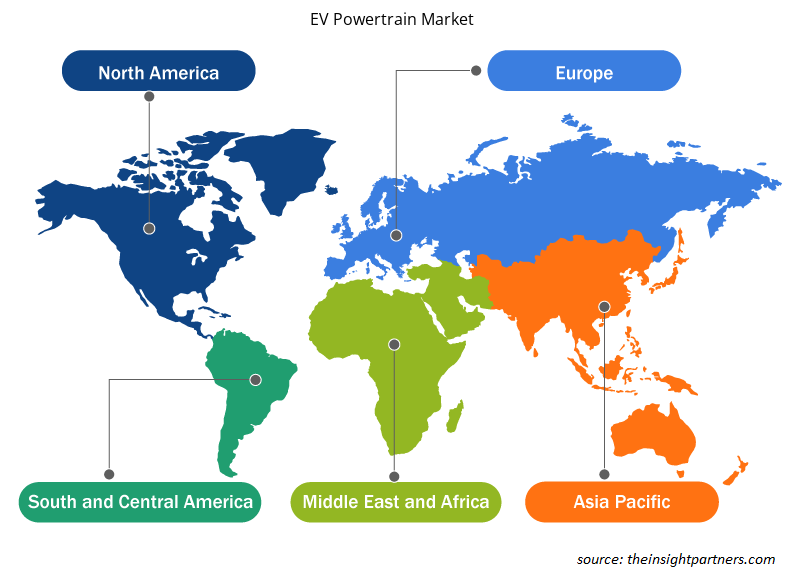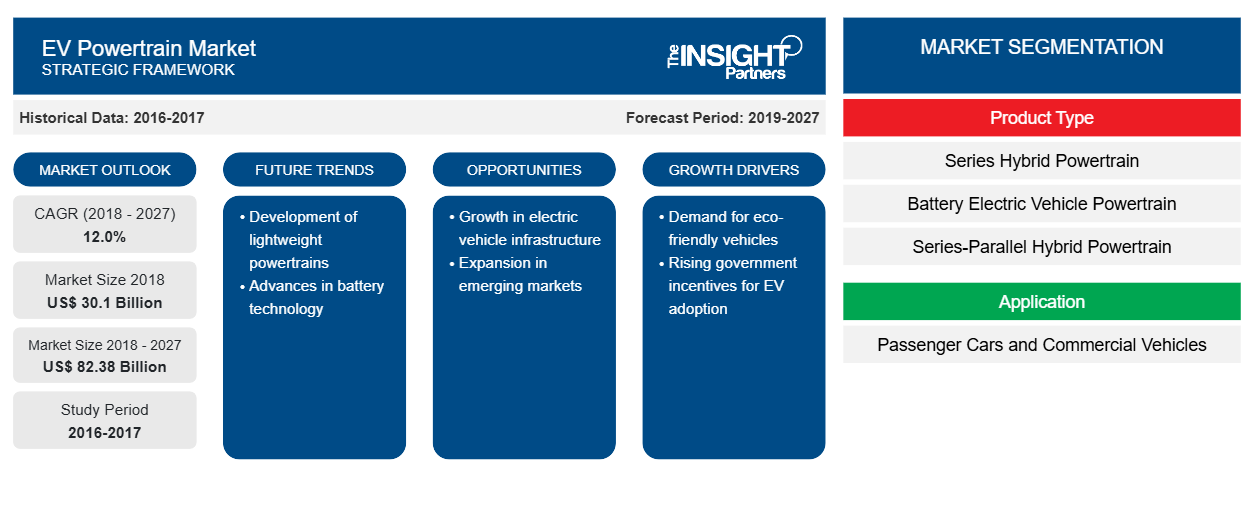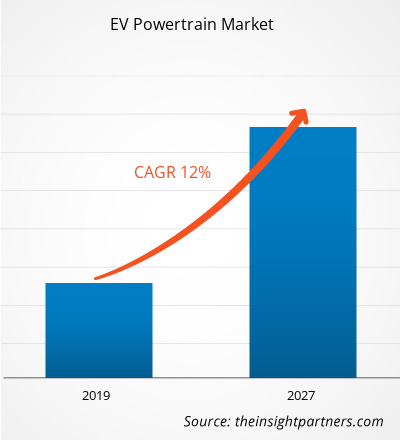2018 年电动汽车 动力总成市场规模为 300.955 亿美元,预计在 2019 年至 2027 年的预测期内复合年增长率为 12.0%,到 2027 年将达到 823.823 亿美元。
从地理上看,电动汽车 动力总成市场分为北美、亚太地区、欧洲和世界其他地区。2018 年,亚太地区以显著的市场份额引领了电动汽车 动力总成市场,预计在 2019 年至 2027 年的预测期内,亚太地区也将成为增长最快的地区。紧随其后的是欧洲,该地区有一些发达国家,汽车行业强劲,预计将推动该地区电动汽车 动力总成市场的增长。而在北美,原始设备制造商和技术提供商不断投入大量资金开发强大的解决方案,以吸引汽车客户。中国是最大的电动汽车制造国,电动汽车的采用率在全球最高,一些国际电动汽车制造商正在中国投资并将其生产部门扩展到中国。例如,特斯拉正在中国上海投资 20亿美元建立新工厂,生产 Model 3 轿车和未来汽车。大众汽车也采取了类似的策略,在中国投资超过 100亿美元,历时六年。
欧洲是电动汽车 动力系统市场的第二大市场。北美仍然是电动汽车 动力系统市场的第三大地理区域。在北美,电动汽车的日益普及、美国和加拿大等国汽车工业的强劲发展以及大量电动汽车 动力系统供应商的存在,是预计支持该地区电动汽车 动力系统市场增长的一些主要因素。
定制此报告以满足您的需求
您可以免费定制任何报告,包括本报告的部分内容、国家级分析、Excel 数据包,以及为初创企业和大学提供优惠和折扣
- 获取此报告的关键市场趋势。这个免费样品将包括数据分析,从市场趋势到估计和预测。
市场洞察
政府推动采用电动汽车 动力系统的举措
全球汽车行业正在经历从传统汽车向电动汽车的重大转变。各国政府都在采取措施推动电动汽车的普及。例如,加拿大政府投资 1.825 亿美元开发电动汽车快速充电网络。此外,2017 年 12 月,加拿大联邦政府发布了“绿色政府战略”,旨在到 2050 年将温室气体排放量减少 80%。此外,据加拿大清洁能源公司称,加拿大政府在 2017 年投资了 10 亿美元用于生产电动汽车。由于产量和需求的增加,2019 年,加拿大市场上有 40 多种电动汽车可供选择。此外,电动汽车占加拿大所有汽车销量的 2.5%。此外,根据GOV.UK 的数据,2019 年 7 月,英国当局投资高达 1 亿美元用于开发下一代电动汽车。因此,政府还与行业领袖合作,加速电动和混合动力汽车的发展。
传统发动机的技术发展
过去几年,汽车技术取得了重大进步,尤其是在替代技术的开发方面。电力驱动系统等技术很可能在汽车领域占据主要份额。发动机正在经历变革,并制定了新的燃油经济性和排放标准。此外,车辆电气化已被视为汽车技术的进步。
产品类型洞察
全球电动汽车动力系统市场按类型分为串联混合动力系统、纯电动汽车动力系统、串并联混合动力系统、轻度混合动力系统、并联混合动力系统。纯电动汽车动力系统部分在电动汽车动力系统市场中占据主导地位,预计在 2019 年至 2027 年的预测期内将继续占据主导地位。在当前的电动汽车动力系统行业中,纯电动汽车动力系统是最受欢迎的电动动力系统。
应用程序洞察
按车型划分,电动汽车动力系统市场进一步细分为乘用车和商用车。电动汽车动力系统市场的乘用车部分占据主导地位,预计在 2019 年至 2027 年的预测期内将继续占据主导地位。全球对乘用车的需求不断增长,这归因于发达国家和发展中国家人口的可支配收入不断增加。
市场举措被视为全球电动汽车动力系统市场最常采用的策略。以下列出了一些近期的市场举措:
2019:大陆集团宣布将在中国开始量产其首款全集成式车轴驱动系统。所生产的电机将用于中国和欧洲 OEM 的车辆。2019
:魁北克水电公司宣布,该公司已投资 8500 万美元以确保 TM4(现称为 Dana TM4)的增长,并确保其在电动动力总成领域的领导地位。自 2018 年 6 月以来,魁北克水电公司作为与 Dana Incorporated 战略合作的一部分,持有子公司 Dana TM4 45% 的股份。2019
:马勒开发了一种全集成模块化混合动力驱动系统,可用于广泛的应用。MAHLE 模块化混合动力系统是一种全集成插电式混合动力驱动系统,包括 2 缸或 3 缸涡轮增压汽油发动机。
电动汽车动力系统市场区域洞察
Insight Partners 的分析师已详细解释了预测期内影响电动汽车动力总成市场的区域趋势和因素。本节还讨论了北美、欧洲、亚太地区、中东和非洲以及南美和中美洲的电动汽车动力总成市场细分和地理位置。

- 获取电动汽车动力系统市场的区域特定数据
电动汽车动力系统市场报告范围
| 报告属性 | 细节 |
|---|---|
| 2018 年市场规模 | 301亿美元 |
| 2027 年市场规模 | 823.8亿美元 |
| 全球复合年增长率(2018 - 2027) | 12.0% |
| 史料 | 2016-2017 |
| 预测期 | 2019-2027 |
| 涵盖的领域 | 按产品类型
|
| 覆盖地区和国家 | 北美
|
| 市场领导者和主要公司简介 |
|
市场参与者密度:了解其对商业动态的影响
电动汽车动力系统市场正在快速增长,这得益于终端用户需求的不断增长,而这些需求又源于消费者偏好的不断变化、技术进步以及对产品优势的认识不断提高等因素。随着需求的增加,企业正在扩大其产品范围,进行创新以满足消费者的需求,并利用新兴趋势,从而进一步推动市场增长。
市场参与者密度是指在特定市场或行业内运营的企业或公司的分布情况。它表明在给定市场空间中,相对于其规模或总市场价值,有多少竞争对手(市场参与者)存在。
在电动汽车动力总成市场运营的主要公司有:
- 大陆汽车集团
- 罗伯特·博世有限公司
- 康明斯公司
- Maxim Integrated Products, Inc.
- 麦格纳国际公司
免责声明:上面列出的公司没有按照任何特定顺序排列。

- 了解电动汽车动力系统市场顶级关键参与者概况
全球电动汽车动力系统市场细分
全球电动汽车动力系统市场 - 按产品类型
- 系列混合动力系统
- 电池电动汽车动力系统
- 串并联混合动力系统
- 轻度混合动力系统
- 并联混合动力系统
全球电动汽车动力系统市场 - 按应用分类
- 乘用车
- 商用车
全球电动汽车动力系统市场 - 按地区划分
北美
- 我们
- 加拿大
- 墨西哥
欧洲
- 法国
- 德国
- 英国
- 瑞典
- 荷兰
- 斯洛伐克
- 欧洲其他地区
亚太地区 (APAC)
- 中国
- 日本
- 印度
- 韩国
世界其他地区 (ROW)
全球电动汽车动力系统市场 - 公司简介
- 大陆汽车集团
- 罗伯特·博世有限公司
- 康明斯公司
- Maxim Integrated Products, Inc.
- 麦格纳国际公司
- 塔塔艾尔克西
- 达纳有限公司
- 法雷奥公司
- 马勒有限公司
- 采埃孚股份公司
- 历史分析(2 年)、基准年、预测(7 年)及复合年增长率
- PEST 和 SWOT 分析
- 市场规模价值/数量 - 全球、区域、国家
- 行业和竞争格局
- Excel 数据集


- Smart Mining Market
- Airport Runway FOD Detection Systems Market
- Single Pair Ethernet Market
- Constipation Treatment Market
- Glycomics Market
- Flexible Garden Hoses Market
- Equipment Rental Software Market
- Adaptive Traffic Control System Market
- Transdermal Drug Delivery System Market
- Sexual Wellness Market

Report Coverage
Revenue forecast, Company Analysis, Industry landscape, Growth factors, and Trends

Segment Covered
This text is related
to segments covered.

Regional Scope
North America, Europe, Asia Pacific, Middle East & Africa, South & Central America

Country Scope
This text is related
to country scope.
常见问题
The passenger vehicle segment led the EV powertrain market, by application. The trend of procurement of passenger cars is increasing at a high rate over the years and the trend is anticipated to continue in the future. Passenger car segment undergo substantial technological advancements year on year, owing to the changes in consumer interests, emergence of new technologies. Also, the trend of procurement of passenger cars is increasing at a decent rate over the years. The increase in awareness among the vehicular customers related to the benefits of electric vehicles has resulted in downsizing of fossil fuel vehicles. Also, several governmental initiatives have propelled the growth of electric passenger cars over the years.
Key players in the automotive market are focusing on investing in the production of electric vehicles. There have been prominent collaborations in recent years between automakers and tech companies to develop technologically advanced electric vehicles. For instance, in December 2019, Fiat Chrysler planned a merger with French automaker PSA Group to focus on the development of electric vehicles. As the market is moving toward EV adaptation, due to changing business strategy in order to innovate, the ICE vehicle manufacturers are shifting their focus towards EVs. Further, with increasing awareness about the rising levels of greenhouse gas emission and negative impacts of the conventional vehicles in the form of increasing population are the major factors propelling key players to invest in electric vehicles
The growth of the EV powertrain market in the Asia-Pacific region is primarily driven by the growing automotive industry. Asia-Pacific EV powertrain market is progressing rapidly with China holding the leading position followed by Japan and South Korea. China dominates the entire Asia-Pacific region in terms of the number of electric vehicles. Pertaining to a growing middle class, high economic growth, and rapid technological advancement have created immense growth opportunities for the various industries especially automotive industry. China has been the largest automotive market globally over the years. The growth in the automotive sector in China has been achieved mainly through the establishment of various joint ventures with car manufacturers such as Volkswagen, General Motors, and others
Trends and growth analysis reports related to Automotive and Transportation : READ MORE..
The List of Companies - EV Powertrain Market
- Continental AG
- Robert Bosch GmbH
- Cummins, Inc.
- Maxim Integrated Products, Inc.
- Magna International Inc.
- Tata Elxsi
- Dana Limited
- Valeo SA
- Mahle GmbH
- ZF Friedrichshafen AG
The Insight Partners performs research in 4 major stages: Data Collection & Secondary Research, Primary Research, Data Analysis and Data Triangulation & Final Review.
- Data Collection and Secondary Research:
As a market research and consulting firm operating from a decade, we have published and advised several client across the globe. First step for any study will start with an assessment of currently available data and insights from existing reports. Further, historical and current market information is collected from Investor Presentations, Annual Reports, SEC Filings, etc., and other information related to company’s performance and market positioning are gathered from Paid Databases (Factiva, Hoovers, and Reuters) and various other publications available in public domain.
Several associations trade associates, technical forums, institutes, societies and organization are accessed to gain technical as well as market related insights through their publications such as research papers, blogs and press releases related to the studies are referred to get cues about the market. Further, white papers, journals, magazines, and other news articles published in last 3 years are scrutinized and analyzed to understand the current market trends.
- Primary Research:
The primarily interview analysis comprise of data obtained from industry participants interview and answers to survey questions gathered by in-house primary team.
For primary research, interviews are conducted with industry experts/CEOs/Marketing Managers/VPs/Subject Matter Experts from both demand and supply side to get a 360-degree view of the market. The primary team conducts several interviews based on the complexity of the markets to understand the various market trends and dynamics which makes research more credible and precise.
A typical research interview fulfils the following functions:
- Provides first-hand information on the market size, market trends, growth trends, competitive landscape, and outlook
- Validates and strengthens in-house secondary research findings
- Develops the analysis team’s expertise and market understanding
Primary research involves email interactions and telephone interviews for each market, category, segment, and sub-segment across geographies. The participants who typically take part in such a process include, but are not limited to:
- Industry participants: VPs, business development managers, market intelligence managers and national sales managers
- Outside experts: Valuation experts, research analysts and key opinion leaders specializing in the electronics and semiconductor industry.
Below is the breakup of our primary respondents by company, designation, and region:

Once we receive the confirmation from primary research sources or primary respondents, we finalize the base year market estimation and forecast the data as per the macroeconomic and microeconomic factors assessed during data collection.
- Data Analysis:
Once data is validated through both secondary as well as primary respondents, we finalize the market estimations by hypothesis formulation and factor analysis at regional and country level.
- Macro-Economic Factor Analysis:
We analyse macroeconomic indicators such the gross domestic product (GDP), increase in the demand for goods and services across industries, technological advancement, regional economic growth, governmental policies, the influence of COVID-19, PEST analysis, and other aspects. This analysis aids in setting benchmarks for various nations/regions and approximating market splits. Additionally, the general trend of the aforementioned components aid in determining the market's development possibilities.
- Country Level Data:
Various factors that are especially aligned to the country are taken into account to determine the market size for a certain area and country, including the presence of vendors, such as headquarters and offices, the country's GDP, demand patterns, and industry growth. To comprehend the market dynamics for the nation, a number of growth variables, inhibitors, application areas, and current market trends are researched. The aforementioned elements aid in determining the country's overall market's growth potential.
- Company Profile:
The “Table of Contents” is formulated by listing and analyzing more than 25 - 30 companies operating in the market ecosystem across geographies. However, we profile only 10 companies as a standard practice in our syndicate reports. These 10 companies comprise leading, emerging, and regional players. Nonetheless, our analysis is not restricted to the 10 listed companies, we also analyze other companies present in the market to develop a holistic view and understand the prevailing trends. The “Company Profiles” section in the report covers key facts, business description, products & services, financial information, SWOT analysis, and key developments. The financial information presented is extracted from the annual reports and official documents of the publicly listed companies. Upon collecting the information for the sections of respective companies, we verify them via various primary sources and then compile the data in respective company profiles. The company level information helps us in deriving the base number as well as in forecasting the market size.
- Developing Base Number:
Aggregation of sales statistics (2020-2022) and macro-economic factor, and other secondary and primary research insights are utilized to arrive at base number and related market shares for 2022. The data gaps are identified in this step and relevant market data is analyzed, collected from paid primary interviews or databases. On finalizing the base year market size, forecasts are developed on the basis of macro-economic, industry and market growth factors and company level analysis.
- Data Triangulation and Final Review:
The market findings and base year market size calculations are validated from supply as well as demand side. Demand side validations are based on macro-economic factor analysis and benchmarks for respective regions and countries. In case of supply side validations, revenues of major companies are estimated (in case not available) based on industry benchmark, approximate number of employees, product portfolio, and primary interviews revenues are gathered. Further revenue from target product/service segment is assessed to avoid overshooting of market statistics. In case of heavy deviations between supply and demand side values, all thes steps are repeated to achieve synchronization.
We follow an iterative model, wherein we share our research findings with Subject Matter Experts (SME’s) and Key Opinion Leaders (KOLs) until consensus view of the market is not formulated – this model negates any drastic deviation in the opinions of experts. Only validated and universally acceptable research findings are quoted in our reports.
We have important check points that we use to validate our research findings – which we call – data triangulation, where we validate the information, we generate from secondary sources with primary interviews and then we re-validate with our internal data bases and Subject matter experts. This comprehensive model enables us to deliver high quality, reliable data in shortest possible time.


 获取此报告的免费样本
获取此报告的免费样本